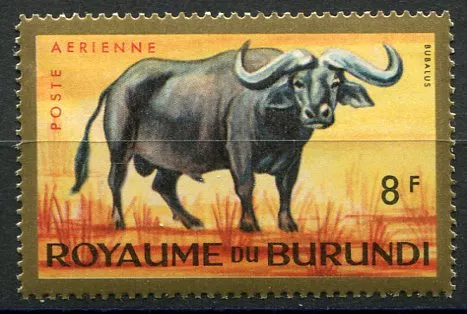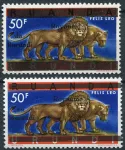- Home
- Philately: postage stamps
- Philately: stamps all over the world
- Africa
- Burundi
- (1964) MiNr. 103 A ** - Burundi - Air Stamp - African Buffalo
(1964) MiNr. 103 A ** - Burundi - Air Stamp - African Buffalo
Burundi - postage stamps.

| Code: | BUR-103A |
| Producer: | Burundi |
| Price: | 0,61 EUR |
| Availability: | In Stock |
| Stock: | 1 Pcs |
| Denomination of the stamp: | 8 F |
| Year: | 1964 |
| Condition: | ** |
| Catalogue no. (MICHEL): | 103 A |
| Cat. number (St. Gibbons): | 93 |
| Cat. number (Yvert et Tellier): | PA 2 |
African buffalo (Syncerus caffer)
The African buffalo (Syncerus caffer), one of the most massive members of the tunicate family, is one of the so-called "Big Five" African fauna. Its distribution, behaviour and ecology are a key subject of study within African savannahs and protected areas.
The buffalo is the most important species in Africa.
Taxonomy and subspecies
.
The African buffalo belongs to the genus Syncerus, family Bovidae. The scientific name Syncerus caffer includes several geographically distinct subspecies:
-
Syncerus caffer caffer - Cape buffalo (southern Africa)
-
Syncerus caffer nanus - forest buffalo (West Africa)
-
Syncerus caffer brachyceros - West African buffalo (between Senegal and Nigeria)
-
Syncerus caffer aequinoctialis - Central African buffalo (e.g. Cameroon, Chad)
The largest and best known is the Cape buffalo, which can weigh up to 900 kg. In contrast, the forest buffalo is much smaller and has a darker, more compact body structure.
Distribution and habitat
The African buffalo is widespread in sub-Saharan Africa, particularly in areas with water availability and grassland. It prefers savannas, wetlands and riverine forests. It avoids arid desert areas and dense tropical rainforests.
It is heavily dependent on water sources, as it needs to drink daily. This makes it vulnerable to climate change and seasonal fluctuations in water availability.
Social structure and behaviour
.
Buffalo live in complex social groups that can number tens to hundreds of individuals. Cows are dominant and form the core of the herd. Older males often form smaller "bachelor" groups or live solitary lives.
The animal is known for its unpredictability and strength. When threatened, it can be very aggressive - even against predators such as lions (Panthera leo). Group defense is common, and buffaloes can band together to protect weaker individuals.
Ecological significance
.
The African buffalo plays a vital role in the ecosystem:
-
Maintains grass cover: grazing helps regulate vegetation.
-
Spreads seeds: helps plants spread through movement and droppings.
- Strong
Serves as prey: is an important food component for predators.
Because of its size and amount of biomass, it also has a significant effect on soil nutrient cycles.
Conservation and status
According to the International Union for Conservation of Nature (IUCN), the African buffalo is classified as Less Concern. Yet it faces threats such as:
-
Loss of natural habitat due to agriculture and urbanization
-
Conflicts with humans, especially due to crop damage
-
Diseases, including foot-and-mouth disease or bovine tuberculosis
Healthy populations are mostly found in protected areas such as national parks and nature reserves.
The African buffalo (Syncerus caffer) is not only a fascinating African artiodactyl, but also an important element in the ecological balance of African savannas. Its physical strength, complex social structure, and resistance to predation make it an exceptional species within the African megafauna.
The
Frequently Bought Together - (1964) MiNr. 103 A ** - Burundi - Air Stamp - African Buffalo
From the Same Category - (1964) MiNr. 103 A ** - Burundi - Air Stamp - African Buffalo
Burundi - postage stamps. * slightly faded paper and partial black decal on glue (all rather from production)
Burundi - postage stamps. * - slight fingerprint on glue on approx. 3 marks
Thailand - postage stamps Postage stamps Thailand.





